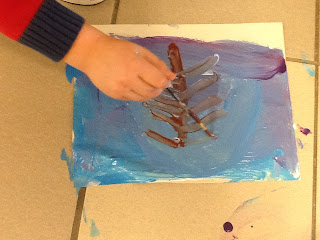How do you know it’s a triangle?
We had examined shapes earlier in the year and had discovered that many students could identify the obvious equilateral triangle but became confused and unsure about triangles when the shape was altered (i.e. when it was flipped/elongated/ turned in different directions). Through a number of discussions it became obvious that students could not agree whether a triangle was still a triangle when the equilateral shape was altered in any way.
Keep in mind this documentation of our latest investigation into triangles took place over a number of days.
Our discussion began with the book A Circle is not a Valentine by H. Werner Zimermann.
Our discussion began with the book A Circle is not a Valentine by H. Werner Zimermann.
When the artist shares his Valentine painting, DG immediately calls out “that’s a triangle, not a Valentine”.
MJ - How do you know that?
DG - It has 3 sides and 3 points.
MJ - Thumbs up if you agree with D.
What was your criteria D?
DG - It has 3 sides and 3 points.
We read the next page and sure enough....
As we read the rest of the book, students continued to share their thinking around the various geometric shapes.
To continue to provoke more thinking around shapes, geoboards were placed at our math centre.
To challenge thinking Van De Walle triangles image was projected on SMARTboard with the simple prompt:
What do you see? (Van De Walle triangles)
(Students were given time to share thinking with a partner before sharing with class).
(Students were given time to share thinking with a partner before sharing with class).
JC - I see an A, I see a C and a D, and I see an I and a B and a I see an L, and ahhh I see an I.
MJ - JC saw lots of letters. What else did you see?
CB - There’s letters and half of the alphabet.
MJ - So you’re noticing the letters as well. What else do you see?
NB - I see a LBNDKLCAB. I see a A and B and C.
MJ - So we agree there’s letters up there. Did anyone see anything different they can share?
RL - The B is trapped and bunch of letters.
CL - I see the number 58.
MJ - Interesting.
RH - I see shapes.
MJ - Tell us more.
RH - There’s triangles, upside down triangles, and side triangles and other triangles.
MJ - How do you know they are triangles?
RH - Because they can be up or down or sideways.
MJ - Interesting, because when I found this in one of my math books it says right down here “assorted triangles”. But I’m thinking how do I know they are triangles?
MJ - D you shared some information yesterday.
DG - You mean about the triangles.
MJ - Yes what do we need to know about triangles?
DG - They have 1,2,3 sides and 3 points 1,2,3.
MJ - What did D just say?
LE - They have 3 sides and 3 points.
MJ - So when you look up there do these shapes all have 3 sides and 3 points? (students again given time to think and then share ideas with a partner).
MJ - What did D tell us again about triangles?
LT - They have 3 sides and 3 points, 1,2,3 and 1,2,3.
LT - Yes it’s ok if they’re upside down or sideways or upside down.
MJ - How do you know that this is a triangle?
LT - Cause it has 3 points and 3 sides.
MJ - How many people agree with L that it’s a triangle (thumbs up or thumbs down).
MJ - J you agree. What do you know about triangles?
J - They can be upwards or upside down or straight or sideways and uh that’s all I know.
Students went on a shape hunt (A variety of triangular shapes and sizes were spread all around the room and each student had to find a shape and talk about it with a partner).
MJ - Tell us about your shape.
CB - It’s still a triangle because it has 3 sides and 3 points 1 2 3.
MJ - If you turn it another way is it still a triangle?
CB - Yes.
MJ - How do you know that?
CB - 1,2,3 (as she touches each side), 1,2,3 (as she touches each point).
MJ - So it still has those 3 points and 3 sides. Interesting.
CB - If you have a shape like this (turns shape so standing tall) it’s kinda like an arrow.
MJ - Is it still a triangle?
CB - (Nods yes).
Students continue to explore shape properties using geoboards and elastics.
Finally students chose a shape and were given the challenge of using that shape to create something new. These are the artistic designs that evolved out of our study of triangles.


























































